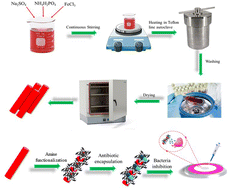Development of a hematite nanotube and tyramine-based drug carrier against drug-resistant bacteria Klebsiella pneumoniae†
Abstract
In this study, hematite nanotube (HNT) and tyramine-based advanced nano-drug carriers were developed for inhibiting the growth of Klebsiella pneumoniae (K. pneumoniae). The HNT was synthesized by following the Teflon line autoclaved assisted hydrothermal process and tyramine was incorporated on the surface of the HNT to fabricate the formulated nano-drug. The nano-drug was prepared by conjugating meropenem (MP) on the surface of Tyramine-HNT and characterized using different techniques, such as scanning electron microscopy (SEM), attenuated total reflection Fourier transform infrared (ATR-FTIR), etc. Furthermore, the drug-loading efficiency and loading capacity were measured using a UV-vis spectrometer. The pH, amount of Tyr, and HNT required for drug loading were optimized. A controlled and gradual manner of pH-sensitive release profiles was found after investigating the release profile of MP from the carrier drug. The antibacterial activity of MP@Tyramine-HNT and MP was compared through the agar disc diffusion method which indicates that antibacterial properties of antibiotics are enhanced after conjugating. Surprisingly, the MP@Tyramine-HNT exhibits a minimum inhibitory concentration (MIC) and minimum bactericidal concentration (MBC) of K. pneumoniae lower than MP itself. These results indicate the nanocarrier can reduce the amount of MP dosed to eradicate K. pneumoniae.



 Please wait while we load your content...
Please wait while we load your content...